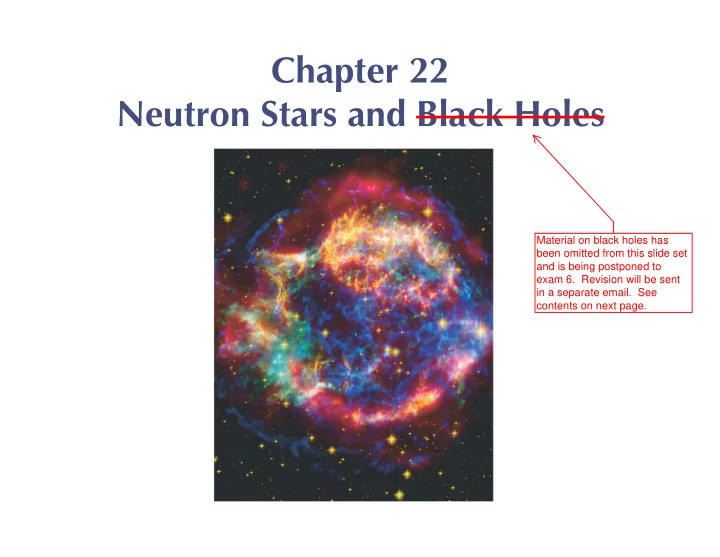

Chapter 22 Neutron Stars and Black Holes Material on black holes has been omitted from this slide set and is being postponed to exam 6. Revision will be sent in a separate email. See contents on next page.
Units of Chapter 22 22.1 Neutron Stars 22.2 Pulsars 22.3 XXNeutron-Star Binaries: X-ray bursters [Look at the slides and the pictures in your book, but I won’t test you on this in detail, and we may skip altogether in class.] 22.4 Gamma-Ray Bursts 22.5 Black Holes 22.6 XXEinstein’s Theories of Relativity Special Relativity 22.7 Space Travel Near Black Holes 22.8 Observational Evidence for Black Holes Tests of General Relativity Gravity Waves: A New Window on the Universe
Neutron Stars and Pulsars (sec. 22.1, 2 in textbook)
22.1 Neutron Stars According to models for stellar explosions: After a carbon detonation supernova (white dwarf in binary), little or nothing remains of the original star. After a core collapse supernova, part of the core may survive. It is very dense—as dense as an atomic nucleus—and is called a neutron star. [Recall that during core collapse the iron core (ashes of previous fusion reactions) is disintegrated into protons and neutrons, the protons combine with the surrounding electrons to make more neutrons, so the core becomes pure neutron matter. Because of this, core collapse can be halted if the core’s mass is between 1.4 (the Chandrasekhar limit) and about 3-4 solar masses, by neutron degeneracy.] What do you get if the core mass is less than 1.4 solar masses? Greater than 3-4 solar masses?
22.1 Neutron Stars Neutron stars, although they have 1–3 solar masses, are so dense that they are very small. This image shows a 1-solar-mass neutron star, about 10 km in diameter, compared to Manhattan: Other important properties of neutron stars (beyond mass and size): • Rotation—as the parent star collapses, the neutron core spins very rapidly, conserving angular momentum. Typical periods are fractions of a second. • Magnetic field—again as a result of the collapse, the neutron star’s magnetic field becomes enormously strong.
22.2 Pulsars The first pulsar was discovered in 1967. It emitted extraordinarily regular pulses; nothing like it had ever been seen before. After some initial confusion (could it be pulsation? An extraterrestrial signal?), it was realized that this was a neutron star, spinning very rapidly. Light curve of pulsar: notice precisely timed periodic pulses.
22.2 Pulsars But why would a neutron star flash on and off? This figure illustrates the lighthouse effect responsible: Strong jets of matter are emitted at the magnetic poles. If the rotation axis is not the same as the magnetic axis, the two beams will sweep out circular paths. If the Earth lies in one of those paths, we will see the star pulse. Pulsars radiate their energy away quite rapidly; the radiation weakens and stops in a few tens of millions of years, making the neutron star virtually undetectable. Pulsars also will not be visible on Earth if their jets are not pointing our way.
22.2 Pulsars There is a pulsar at the center of the Crab Nebula, which “blinks” about 30 times per second. The images show it in the “off” and “on” states. The disk and jets are also visible:
Neutron Star Binaries and X-ray bursters This is sec. 22.3 in textbook, which will not be on exam 5: We are skipping material on binary star phenomena. Slides are here only in case you are interested in the bare essentials)
22.3 Neutron-Star Binaries Bursts of X-rays have been observed near the center of our galaxy. A typical one appears below, as imaged in the X-ray spectrum: These X-ray bursts are thought to originate on neutron stars that have binary partners. The process is similar to a nova, but much more energy is emitted due to the extremely strong gravitational field of the neutron star.
22.3 Neutron-Star Binaries Most pulsars have periods between 0.03 and 0.3 seconds, but a new class of pulsar was discovered in the early 1980s: the millisecond pulsar. Millisecond pulsars are thought to be “spun-up” by matter falling in from a companion. This globular cluster has been found to have 108 separate X-ray sources, about half of which are thought to be millisecond pulsars:
22.3 Neutron-Star Binaries In 1992, a pulsar was discovered whose period had unexpected, but very regular, variations. These variations were thought to be consistent with a planet, which must have been picked up by the neutron star. See diagram below.
Gamma-ray Bursts sec 22.4 in textbook
22.4 Gamma-Ray Bursts Gamma-ray bursts also occur, and were first spotted by satellites looking for violations of nuclear test-ban treaties. This map of where the bursts have been observed shows no “clumping” of bursts anywhere, particularly not within the Milky Way. Therefore, the bursts must originate from outside our Galaxy.
22.4 Gamma-Ray Bursts These are some sample luminosity curves for gamma-ray bursts: Distance measurements of some gamma bursts show them to be very far away—2 billion parsecs for the first one measured. Occasionally the spectrum of a burst can be measured, allowing distance determination (using a method that will be explained in a later chapter.
22.4 Gamma-Ray Bursts Two models—merging neutron stars or a hypernova—have been proposed as the source of gamma-ray bursts:
22.4 Gamma-Ray Bursts This burst had a light curve that looks very much like an exceptionally strong supernova, lending credence to the hypernova model:
Summary of Chapter 22 • Supernova may leave behind a neutron star. • Neutron stars are very dense, spin rapidly, and have intense magnetic fields. • Neutron stars may appear as pulsars due to the lighthouse effect. • A neutron star in a close binary may become an X-ray burster or a millisecond pulsar. • Gamma-ray bursts are probably due to two neutron stars colliding or hypernova.
Recommend
More recommend